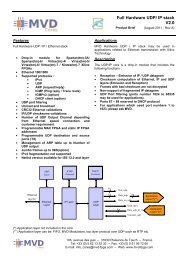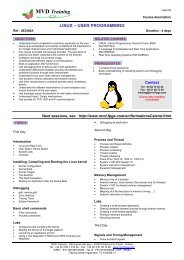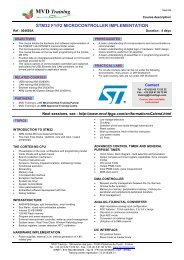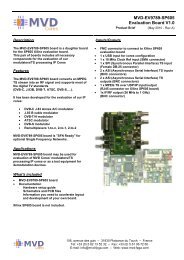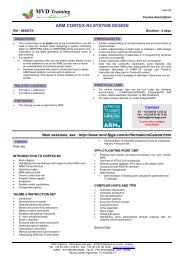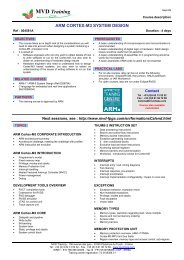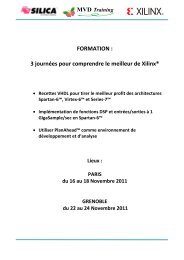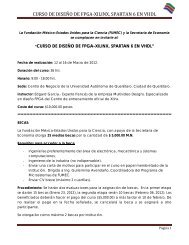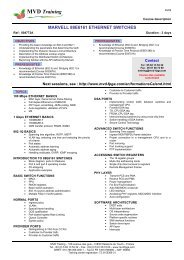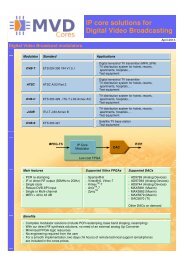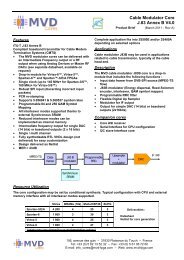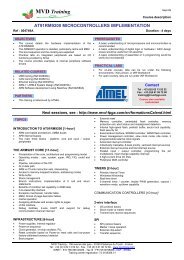Writing RTL Code for Virtex-4 DSP48 Blocks with XST 8.1i
Writing RTL Code for Virtex-4 DSP48 Blocks with XST 8.1i
Writing RTL Code for Virtex-4 DSP48 Blocks with XST 8.1i
You also want an ePaper? Increase the reach of your titles
YUMPU automatically turns print PDFs into web optimized ePapers that Google loves.
ture, it is important to write the code in a simple way, giving your<br />
tools the best option to pack your desired functions into each <strong>DSP48</strong><br />
block. For this reason, each code has been written in a single process.<br />
The more simple and compact your <strong>RTL</strong> code, the more efficient<br />
the synthesis result. Of course, depending on your synthesis<br />
tool, other alternatives can also give you excellent results, but they<br />
will be more dependent on the synthesis tools.<br />
Higher Complexity Designs<br />
What happens when you need more complex DSP functions You<br />
can use a similar approach <strong>for</strong> many complex DSP algorithm implementations<br />
by describing each block separately to ensure optimal<br />
synthesis results.<br />
You will find many other examples, most of them directly related<br />
to those explained in their algorithmic and schematic <strong>for</strong>m, in<br />
the XtremeDSP User Guide.<br />
Conclusion<br />
This article is excerpted from the application note, “<strong>Virtex</strong>-4 <strong>DSP48</strong><br />
Inference,” which is available at www.mvd-fpga.com/en/publi_<br />
V4_<strong>DSP48</strong>.html.<br />
The application note includes additional examples, such as:<br />
• Single DSP slice 35 x 18 multiplier (Figure 1-18 in the<br />
XtremeDSP User Guide)<br />
• Single DSP slice 35 x 35 multiplier (Figure 1-19 in the<br />
XtremeDSP User Guide)<br />
• Fully pipelined complex 18 x 18 multiplier (Figure 1-22<br />
in the XtremeDSP User Guide)<br />
• High-speed FIR filter (Figure 1-17 in the XtremeDSP<br />
User Guide)<br />
The application note also describes many of the important features<br />
of <strong>DSP48</strong> blocks supported by <strong>XST</strong> <strong>8.1i</strong> and Synplify-Pro 8.2. MAP<br />
reports, Timing Analyzer reports, and a detailed view of the FPGA<br />
Editor show the efficiency of the synthesis and implementation tools.<br />
You can also see how the cascade chain between adjacent <strong>DSP48</strong> slices<br />
is used to improve both per<strong>for</strong>mance and power consumption. Almost<br />
all of these widely used configurations provide the best implementation<br />
results – in terms of resources used as well as per<strong>for</strong>mance.<br />
However, some remaining limitations are also described. We expect<br />
these few points to be resolved in future releases.<br />
For more in<strong>for</strong>mation, see the XtremeDSP Design<br />
Considerations User Guide at www.xilinx.com/bvdocs/userguides/<br />
ug073.pdf. The methodology is clearly explained and implementation<br />
results analyzed in detail, <strong>with</strong> ISE software tools like<br />
Timing Analyzer and FPGA Editor.<br />
Multi Video Designs (MVD) is a training and design center specializing<br />
in FPGA designs, PowerPC processors, RTOS <strong>for</strong> embedded/real-time<br />
applications, and high-speed buses like PCI Express<br />
and RapidIO. MVD as an Approved Training Partner and a member<br />
of the Xilinx XPERTS program, <strong>with</strong> offices in France, Spain,<br />
and South America.<br />
<strong>XST</strong> Support <strong>for</strong> <strong>DSP48</strong> Inference<br />
<strong>XST</strong>, the synthesis engine included <strong>with</strong> the Xilinx ®<br />
ISE toolset, contains extensive support <strong>for</strong> inference of<br />
<strong>DSP48</strong> macros. A number of macro functions are recognized<br />
and mapped to these dedicated resources, including<br />
adders, subtracters, multipliers, and accumulators, as well as<br />
combinations like multiply-add and multiply-accumulate<br />
(MAC). Register stages can be absorbed into the <strong>DSP48</strong><br />
blocks, and direct connect resources are used to cascade<br />
large or multiple functions.<br />
Macro implementation on <strong>DSP48</strong> blocks is controlled<br />
by the USE_<strong>DSP48</strong> constraint <strong>with</strong> a default value of<br />
auto. In auto mode, <strong>XST</strong> attempts to implement all a<strong>for</strong>ementioned<br />
macros except adders or subtracters on <strong>DSP48</strong><br />
resources. To push adders or subtracters into a <strong>DSP48</strong>, set<br />
the USE_<strong>DSP48</strong> constraint value to yes.<br />
<strong>XST</strong> per<strong>for</strong>ms automatic resource control in auto mode<br />
<strong>for</strong> all macros except adders and subtracters. In this mode<br />
you can control the number of available <strong>DSP48</strong> resources<br />
<strong>for</strong> synthesis using the DSP_UTILIZATION_RATIO<br />
constraint, specifying either a percentage or absolute number.<br />
By default, <strong>XST</strong> tries to utilize, as much as possible, all<br />
available <strong>DSP48</strong> resources <strong>with</strong>in a given device.<br />
With the <strong>8.1i</strong> release of ISE software, <strong>XST</strong> has introduced<br />
further enhancements to its DSP support. <strong>XST</strong> can<br />
now infer loadable accumulators and MACs, which are<br />
critical <strong>for</strong> filter applications. <strong>XST</strong> can recognize chains of<br />
complex filters or multipliers – even across hierarchical<br />
boundaries – and will use dedicated fast connections to<br />
build these <strong>DSP48</strong> chains. The Register Balancing optimization<br />
feature will consider the registers <strong>with</strong> <strong>DSP48</strong><br />
blocks when optimizing clock frequencies. Consult the<br />
<strong>XST</strong> User Guide (http://toolbox.xilinx.com/docsan/xilinx7/<br />
books/docs/xst/xst.pdf) <strong>for</strong> details about coding styles, and<br />
watch the synthesis reports <strong>for</strong> specific implementation<br />
results <strong>for</strong> your <strong>Virtex</strong>-4 designs.<br />
– David Dye<br />
Senior Technical Marketing Engineer<br />
Xilinx, Inc.<br />
Fourth Quarter 2005 Xcell Journal 00



